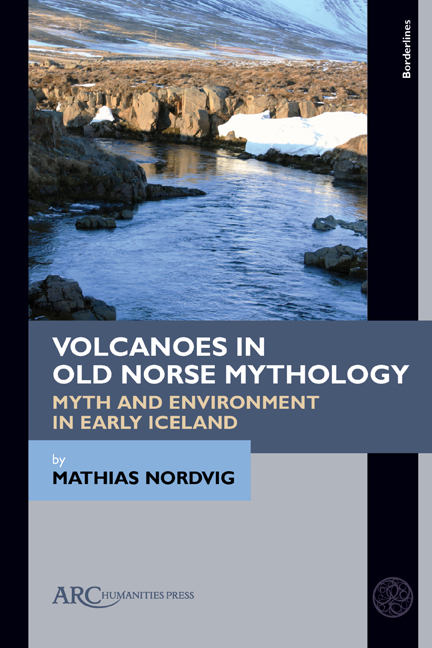Book contents
- Frontmatter
- Contents
- Introduction
- Chapter 1 Old Norse Mythology Between Environment and Literature
- Chapter 2 An Indigenous Theory of Volcanism in Iceland
- Chapter 3 Volcanism in Old Norse Cosmogony
- Chapter 4 Volcanoes in the Social Order of Old Norse Mythology
- Chapter 5 Volcanoes as a Cosmological Principle in Old Norse Mythology
- Bibliography
- Index
Chapter 3 - Volcanism in Old Norse Cosmogony
Published online by Cambridge University Press: 13 April 2021
- Frontmatter
- Contents
- Introduction
- Chapter 1 Old Norse Mythology Between Environment and Literature
- Chapter 2 An Indigenous Theory of Volcanism in Iceland
- Chapter 3 Volcanism in Old Norse Cosmogony
- Chapter 4 Volcanoes in the Social Order of Old Norse Mythology
- Chapter 5 Volcanoes as a Cosmological Principle in Old Norse Mythology
- Bibliography
- Index
Summary
IN THE CREATION myth, as it was written by Snorri Sturluson in the Edda, there are multiple inconsistencies in the nature image that he presents. It is widely recognized that Snorri's prose version of the creation myth, which is otherwise found in brief poetic stanzas in Eddic poetry, is wrought with medieval philosophy and theories about the pre-Christian religion. However, underneath the surface of the Latinate script-world, it is possible to detect a coherent natural image that corresponds with observable volcanic phenomena in Iceland.
It seems that the inconsistencies in Snorri's version of the myth relate to his attempt to reconcile older versions of the creation myth with the dominant Neoplatonic philosophy in the thirteenth century. When extracted from its learned entanglement, the older layer of the creation myth appears as an indigenous Icelandic myth, where inherited mythologies from Scandinavia intersect with the Icelandic landscape. The inherited myth from Scandinavia is presumably the story about how humans originate from a primordial chthonic being, who possibly also represented the cosmos, at least the earth. This is an ancient myth that can be traced back to Tacitus's account of the myth of origin among Germanic tribes in the first century AD.
Scandinavians may have reproduced the myth in various ways, but in Iceland it seems to have gained additional imagery from the geologic conditions there. It represents an aspect of an indigenous theory about the origin of volcanism. It describes volcanic phenomena in terms of analogies between lava, ash, glacial bursts, ice, water, poison, snow, and sand. Lacking a vocabulary with which to express their observations, the early Icelanders used analogies, metaphors, and metonymic circumlocutions to conceptualize the natural phenomena in social memory. Beyond delivering a context for a phenomenon with which the early Icelanders were not familiar, as no part of continental northern Europe has active volcanoes, the myth provides an explanation for the social order in early Icelandic society.
With a grounding in observable natural phenomena, the creation myth also offers a perspective on the cosmos that states that the social order has been generated from the environment.
- Type
- Chapter
- Information
- Volcanoes in Old Norse MythologyMyth and Environment in Early Iceland, pp. 55 - 72Publisher: Amsterdam University PressPrint publication year: 2021



